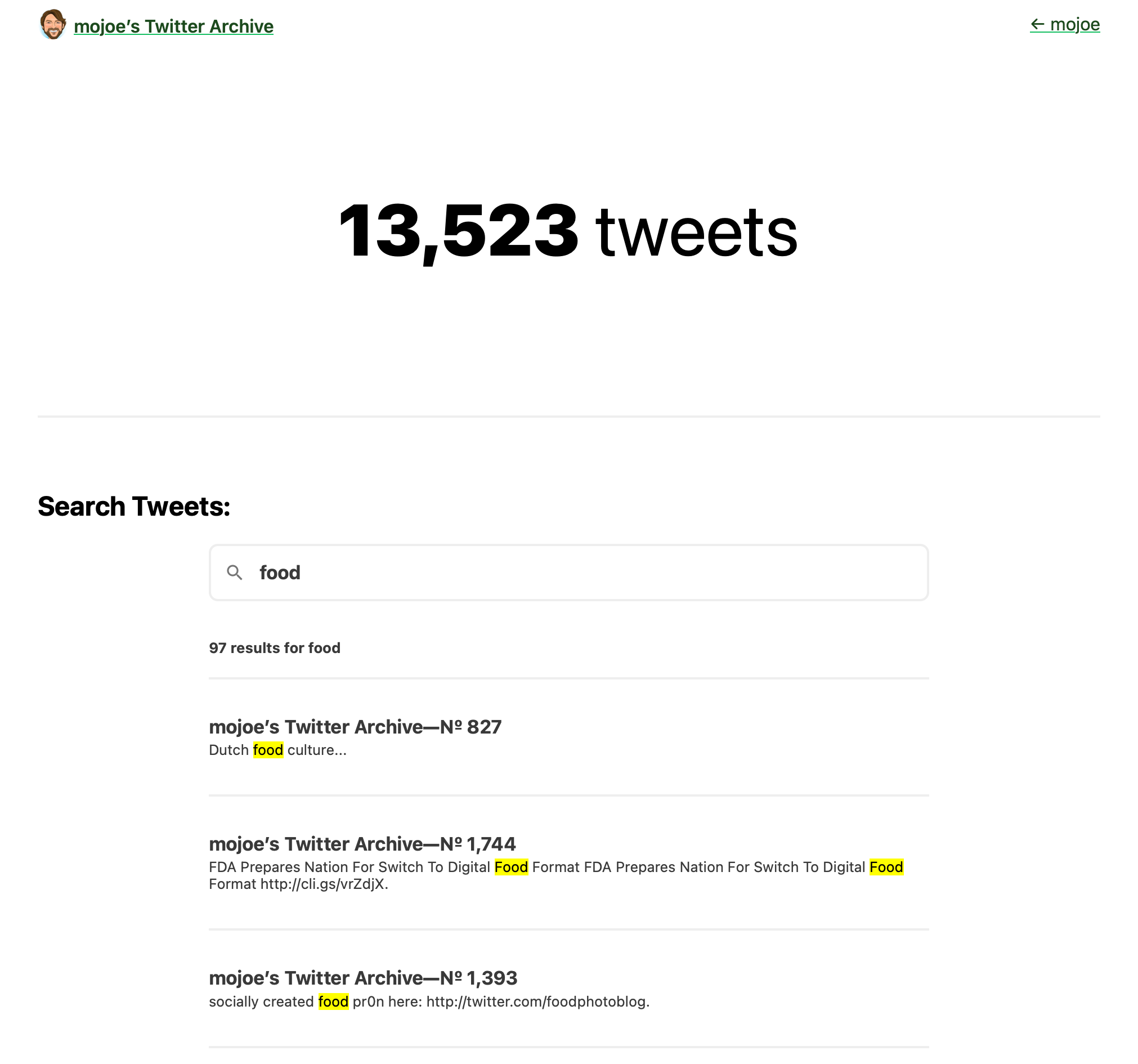Shortly after Elon Musk’s acquisition of Twitter was finalized in 2022, and after approximately 16 years and some 13.5k tweets as @mojoe, I moved to mastodon and the fediverse as my preferred short-form social network platform.
In a narrow sense, my account is ‘just a collection of tweets’. But, thanks to the comparatively long span of time I was active, it also serves as a defacto window on my explorations and progression through several different professional eras. The changing shape of my social and interest graphs, and the record of public sharing and back-and-forth interactions, encode a set of meaningful relationships and participation in a long-standing global community. In short, it’s a slice of history worth ‘saving’, in some form.

Like many, I intended to remove my data from twitter immediately after moving. Being honest, my motives included a dose of pique at what I saw as the rapid, willful ruination (yes, as in destruction…) of one of the few genuinely innovative global social utilities to emerge from the Internet era. (The list of durable, valuable things to come out of the recent Cambrian explosion of new digital media is unfortunately short…). Mostly, I wanted to avoid advancing the various political and cultural agendas of Twitter’s new owners.
Last week, after several unsuccessful attempts, I was able to download a viable copy of my twitter data, and use open-source tools to generate several versions of a portable twitter archive I can publish and manage independently.
In the intervening 18 months, I’ve realized these postings and conversations offer largely historical perspective and value for me – and surely only peripheral utility for anyone else – so it’s sufficient if I have control over the account and the data going forward. In practical terms, this means publishing an archived copy of the account here, on a platform I control, with the ability to delete or de-activate the dormant original as needed. I’ll leave the mothballed account as a bridge to the rapidly growing fediverse, for interested folks.
As a benefit of the DIY builder approach to a Twitter archive, I spent more time in the code-focused web application spaces I first re-touched as part of reconstructing my original blog, and setting up JoeLamantia.org as forward-looking platform. I don’t see returning the strong developer focus of my very first technology / Internet roles, but learning basics of wp cli, working with python and javascript, and navigating text data manipulation was a rewarding return to my roots.
In terms of outcomes from building this kind of historical corpus, in addition to easily citing my own tweets – something to be discrete with – it can be fun to see what’s in there. A friend used the lightweight query capability to identify tweets with ‘design’, and got back this summary from ChatGPT:
“Here is a summary of the provided tweets from mojoe’s Twitter archive, focusing on the 610 results related to “design”:
- Design Thinking and Innovation:
- Several tweets reference articles and resources on design thinking, such as “The OTHER Design Thinking” by Humantific and “Innovation Matrix: Design-Led Innovation from Philips.” These tweets suggest an interest in different approaches and frameworks within design thinking.
- Design-Related Discussions:
- Interaction with other users about design, such as a mention of a “design fiction lecture” and a critique of certain design practices as “design-washing” and “data-washing,” indicating a critical view of superficial design implementations.
- General Themes:
- The remainder of the tweets covers a broad range of topics, including political opinions, social commentary, and personal thoughts on various issues. These tweets do not directly relate to design but provide context on mojoe’s broader interests and viewpoints.
Overall, the tweets reflect a strong engagement with design thinking and innovation, alongside a diverse array of other topics.”
As quick summaries go, this is not bad. It’s not the most insightful, but it spotlights some of the more distinctive and impactful (read, condensed, and sometimes provocative…) instances of phrasing that twitter’s shorter-form conversation architecture encouraged. However, as soon as analysis moves beyond gauging and describing purely functional aspects like framing, contents, structure, etc., you’re in the ambiguous territory of ‘aiming for good taste‘. Of course, good taste is ultimately the goal of most forms of assessment – including specialized critique – but it’s also something to be careful to ask for from an LLM, even when you’re feeling generous about their current capabilities.
With a corpus of meaningful linguistic data I’m familiar with as the originator, I’m (moderately?) inclined to keep exploring new LLM-based tools to understand where they’re relevant.

Leave a Reply